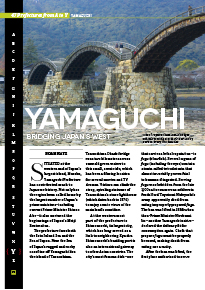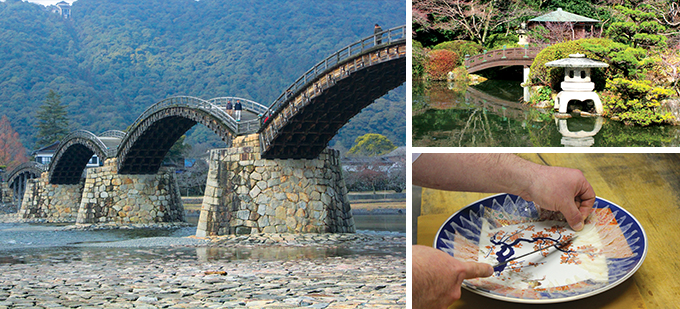Home > Highlighting JAPAN >Highlighting Japan March 2015> 47 Prefectures from A to Y
Highlighting JAPAN

47 Prefectures from A to Y
Yamaguchi
Bridging Japan’s West

Situated at the western end of Japan’s largest island, Honshu, Yamaguchi Prefecture has contributed much to Japanese history. Not only has the region been called home by the largest number of Japan’s prime ministers—including current Prime Minister Shinzo Abe—it also nurtured the beginnings of Japan’s Meiji Restoration.
The prefecture faces both the Seto Inland Sea and the Sea of Japan. Near the Sea of Japan’s rugged and rocky coastline off Yamaguchi lies the island of Tsunoshima. Tsunoshima Ohashi bridge runs two kilometers across emerald green waters to this small, scenic isle, which has been a filming location for several movies and TV dramas. Visitors can climb the steep, spiraling staircase of Tsunoshima’s stone lighthouse (which dates back to 1876) to enjoy scenic views of the mainland’s coastline.
At the westernmost part of the prefecture is Shimonoseki, its largest city, which has long served as a link to neighboring Kyushu. Shimonoseki’s bustling port is also an international gateway to other Asian countries. The city’s most famous dish—one that carries a lethal reputation—is fugu (blowfish). Several organs of fugu (including the eyes) contain a toxin called tetrodotoxin that almost invariably proves fatal to humans if ingested. Serving fugu was forbidden from the late 1500s after numerous soldiers in feudal lord Toyotomi Hideyoshi’s army apparently died from eating improperly prepared fugu. The ban was lifted in 1888 when then-Prime Minister Hirobumi Ito—another Yamaguchi native—declared the delicacy fit for consumption again. Chefs that prepare fugu must be properly licensed, making death from eating one a rarity.
After the ban was lifted, the first place authorized to serve fugu was the landmark restaurant Shunpanro. The chef there cuts the flesh in thin, translucent slices, arranging them artfully on a large, circular porcelain plate, typically in the shape of a chrysanthemum. The chef’s skill is evident in the speed in which the dish is prepared, the thinness of the slices, and of course the exquisite design itself.
Also located in Shimonoseki is the historic area of Jokamachi (“Castle Town”) Chofu. Chofu Garden contains three white traditional storehouses and a sprawling Japanese garden with a pond, perfect for a leisurely stroll. “If visitors staying in Shimonoseki City contact the city’s International Affairs Division, they can wear kimono and have their photos taken in the garden with traditional samurai armor,” says Sadatoshi Ueta, section chief of Shimonoseki City’s International Affairs Division.
Narrow streets in another part of this historic town run through the old samurai quarter. Other than the well-preserved Chofu Mori Residence, however, few of the ancient homes remain, although walls of earth and stone still enclose the town’s inhabitants. Also close by is Kouzan-ji temple, which is where the movement to overthrow the shogun and reinstate the Meiji emperor began.
Near the prefecture’s border with Hiroshima Prefecture is the city of Iwakuni, home of the famous Kintaikyo Bridge. First constructed in 1673, this wooden bridge features five sections with graceful arches that span the Nishiki River below. Portions of the bridge are rebuilt every twenty years. At about two hundred meters in length and five meters in width, Kintaikyo Bridge is one of Japan’s three great bridges. Asahi Shuzo Brewery, producer of the celebrated Dassai brand of Japanese sake, is located in the mountains near Iwakuni.
Yamaguchi has many more historical cities, sights and culinary offerings than the few described above. This region invites travelers to step out of the hectic modern world and cross over the waters of imagination to envision the beginnings of Japan’s modernization.
© 2009 Cabinet Office, Government of Japan






